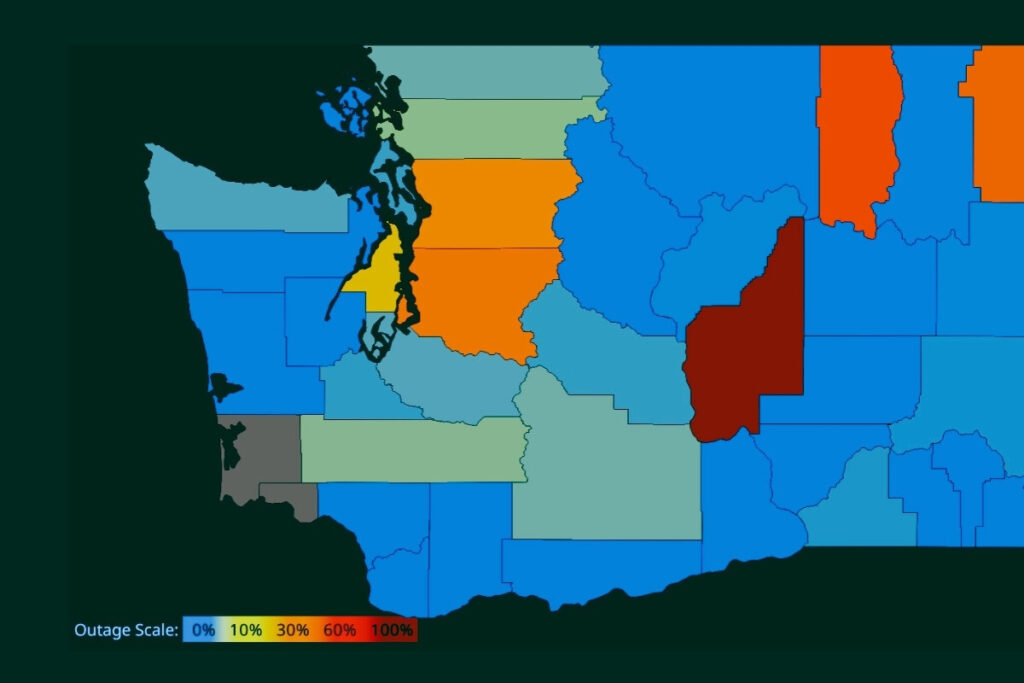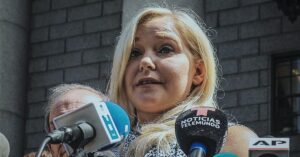A fierce winter storm dubbed a “bomb cyclone” has swept through the Pacific Northwest, leaving hundreds of thousands of homes and businesses in Washington without power. This powerful storm brought damaging wind gusts and heavy rain, causing widespread disruption and challenging conditions for residents and emergency crews alike.
‘Bomb Cyclone’ Brings Strong Winds to Western Washington
On Wednesday, a massive winter storm hit western Washington with relentless force. Wind gusts reached up to 55 mph at Sea-Tac Airport and soared as high as 77 mph in Mount Rainier National Park, according to the National Weather Service (NWS) in Seattle.
This “bomb cyclone” rapidly intensified, bringing strong winds and heavy rainfall that led to numerous power outages and significant tree damage across the region.
The NWS forecasted that while the storm had already caused extensive power disruptions and tree damage, it was expected to continue bringing blizzard conditions to the Cascades.
Also Read
Additionally, thunderstorms were possible along the coast, with another front on the horizon for Friday. This means that unsettled weather could persist through the weekend and into early next week, prolonging the challenges for those affected.
Power Outages as a result of a Bomb Cyclone
The storm’s impact has been severe, with nearly 600,000 people experiencing power outages the morning after the storm hit western Washington. Puget Sound Energy (PSE) has the highest number of affected customers, reporting that 417,683 households are currently without power. Snohomish Public Utilities District (PUD) and Seattle City Light also grapple with significant outages, with 86,152 and 84,720 customers in the dark, respectively.

King County has been particularly hard hit, with extensive damage to power lines and numerous downed trees complicating restoration efforts. PSE has warned that the scale of the storm’s damage may mean some residents could be without power for multiple days. The company has urged customers to make alternate plans as crews work diligently to assess the situation and restore electricity.
Restoring power to such a vast number of households is a monumental task. PSE reported extensive downed power lines, making it dangerous for crews to work in certain areas. Additionally, fallen trees block access to some neighborhoods, slowing the repair process. To expedite restoration, PSE has brought additional power crews from outside Puget Sound.
Seattle City Light faces challenges as crews navigate high wind speeds, downed power lines, and fallen trees. This means that restoring power might take longer than usual. However, the company has assured residents that crews work around the clock to get electricity back to everyone as swiftly and safely as possible.
How to Stay Safe During the Outage?
During a power outage, safety is paramount. The Washington State Department of Health recommends several precautions to help you stay safe until power is restored:
- Limit Appliance Use: Turn off lights and electrical appliances except for the refrigerator and freezer. This helps prevent food spoilage and reduces the risk of electrical surges when power returns.
- Protect Electronics: Unplug computers and other sensitive equipment to protect them from possible surges. This can save your devices from damage once the power is back on.
- Use Safe Lighting: Instead of candles, which can pose a fire hazard, use battery-operated flashlights or glow sticks for lighting. This reduces the risk of accidental fires.
- Avoid Downed Lines: Stay at least 30 feet away from downed power lines or sagging trees with broken limbs. These lines may still be energized and dangerous.
- Conserve Water: If you rely on well water, use it sparingly to ensure you have enough until power returns.
Additionally, never use gas ovens, gas ranges, barbecues, or portable heaters for indoor heating. These can produce carbon monoxide, leading to suffocation. If you must use alternative heating methods, ensure proper ventilation and have a carbon monoxide detector in place.
Key points to expect during a power outage
With nearly 600,000 people affected, life without power can be challenging. Here’s what you might experience and how to cope:
- Limited Lighting: Visibility can drop significantly without electricity, especially at night. Keep a flashlight or a battery-powered lamp handy to navigate your home safely.
- Food Spoilage: Minimize opening your fridge and freezer to keep food cold longer. Plan meals that require minimal cooking to reduce reliance on appliances.
- Communication Challenges: Phone lines and the internet might be down or unreliable. If possible, stay informed through a battery-powered radio and contact neighbors for support.
- Heating and Cooling: If it’s cold, dress in layers and use blankets to stay warm. Avoid using unsafe heating methods to prevent carbon monoxide poisoning.
Important actions to take during a power outage
In times like these, community support is crucial. Here are some ways communities and individuals are helping each other:
- Check on Neighbors: Reach out to family members, friends, and neighbors, especially those who are elderly or have special needs. A simple check-in can make a big difference.
- Stay Informed: Keep up with local news and updates from utility companies through battery-powered radios or mobile alerts. This helps you stay aware of restoration efforts and safety advisories.
- Emergency Supplies: Ensure you have essentials like water, non-perishable food, medications, and batteries on hand. This preparation can help you manage until power is restored.
- Shelters and Assistance: Local shelters may be open for those who need a safe place or additional support. Check with community centers or local government websites for information on available resources.
Why the Storm Was So Powerful
The term “bomb cyclone” refers to a rapidly intensifying storm. These storms develop when a low-pressure system drops in pressure quickly, leading to stronger winds and more severe weather conditions. The bomb cyclone that hit Washington created the perfect conditions for heavy rain, strong winds, and significant power outages. The rapid intensification made the storm more destructive than typical winter storms, resulting in the widespread damage we’re witnessing.
The National Weather Service warns that the storm’s effects might linger. With another front expected to arrive on Friday, the unsettled weather could continue through the weekend and into early next week. Here’s what to expect:
- Blizzard Conditions: The Cascades could see heavy snowfall and strong winds, making travel dangerous and complicating restoration efforts. If you live in these areas, stay indoors and avoid unnecessary travel.
- Thunderstorms: thunderstorms could bring additional rain and gusty winds along the coast, potentially causing more power outages and flooding.
- Extended Outages: Given the storm’s severity, some areas might experience power outages for several days. Utility companies are working tirelessly, but the extent of the damage means some outages could take longer to resolve.
Tragically, the storm has also resulted in the loss of at least one life. Authorities are investigating the circumstances surrounding this death, but it serves as a sobering reminder of the storm’s power and the importance of taking safety precautions seriously. Our thoughts are with those affected by this loss during such a difficult time.
How to Stay Safe During the Storm?
As the storm continues, here are additional safety tips to keep in mind:
- Stay Indoors: Avoid going outside unless necessary. High winds and heavy rain can be hazardous and increase the risk of injury.
- Secure Your Home: Protect your property by securing loose items that could become projectiles in strong winds. This includes outdoor furniture, decorations, and other items the wind could pick up.
- Emergency Kit: Keep an emergency kit with essentials like food, water, medications, and first aid supplies. Having these items on hand can make a significant difference during extended outages.
- Stay Warm: If the temperature drops, use blankets and warm clothing to stay comfortable. Avoid overloading your heating sources to prevent fire hazards and carbon monoxide poisoning.
The bomb cyclone has left a significant mark on western Washington, with widespread power outages and ongoing challenges. While the road to full restoration is long, the determination of utility crews and community support are key to overcoming this adversity.
Stay safe, stay informed, and support one another as we navigate this storm together. Remember to follow safety guidelines, prepare for ongoing weather changes, and seek help if needed. Together, we can weather this storm and come out stronger on the other side.






